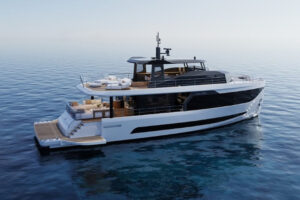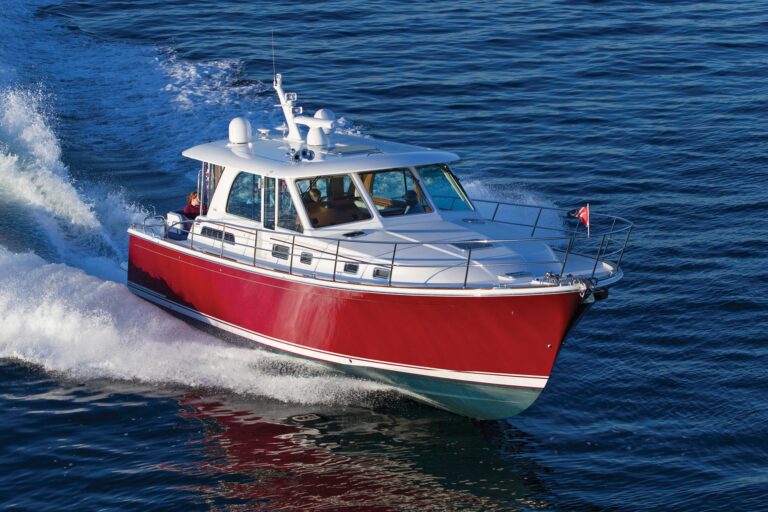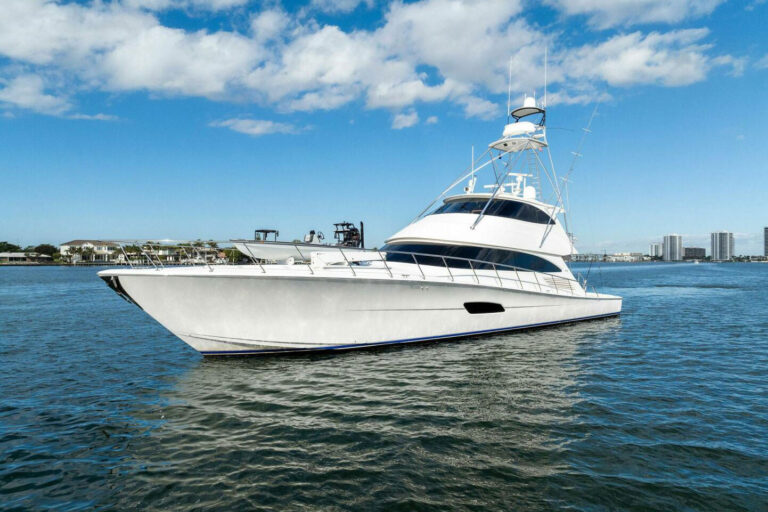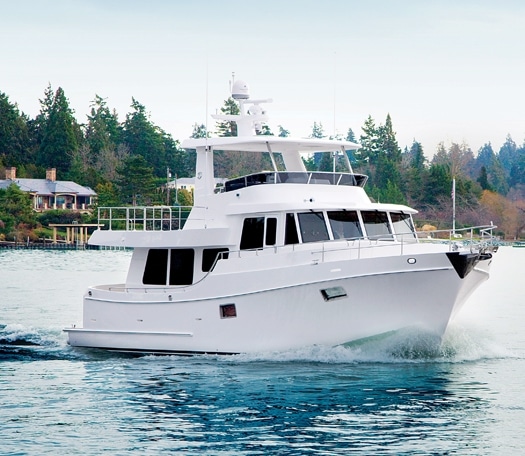
ytgsep14oa525.jpg
Alexander Chueh was a Taiwanese hardware manufacturer with no plans to become a boatbuilder until he acquired a boatyard as payment of a debt in the 1970s. However, he threw himself into his new business with the same dedication to detail that had made him a successful entrepreneur.
Over the following decades, Ocean Alexander carved a niche as a builder of fine yachts, and certainly one of those that turned around American attitudes toward boats from the Far East. Chueh quickly signed yacht designer Ed Monk, Jr., who had a reputation for tough and seaworthy yachts in the Pacific Northwest, and their first offering was, no surprise, a sturdy trawler.
Now run by Alex’s son, John Chueh, Ocean Alexander has gone back to its roots with the new 60-foot Trawler Extended Cruiser. If you think that the “extended” means it’s designed for voyaging, well, you’re halfway right. It’s certainly aimed at the offshore cruising market, but it’s also a stretch version of the already popular Ocean Alexander 54 Trawler.
Once again the lines are by Monk, and one glance tells you this yacht is an offshore cruiser, from the no-nonsense flared bow and Portuguese bridge to the absence of the frills and design affectations found on marina queens. Walkaround decks on each side are made secure by high bulwarks capped by stainless steel rails, husky rubbing strakes handle the occasional piling, and the bridgedeck extends full beam to protect the salon and main deck from both sun and rain.
Underwater, the 60 Trawler has come a long way from those early Monk warped-plane hull lines, and sports what Ocean Alexander calls the “S-bow,” with a melon-seed-shape, rather than a round one. We didn’t have enough seas on our test run to challenge the S-bow, but the company says that the shape dampens pitch and lowers resistance up to five percent at both displacement and semi-displacement speeds.
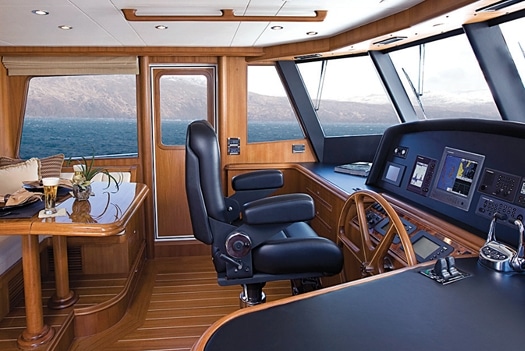
| | |
With a fine Florida day, we did all of our on-water testing from the flying bridge, which, when combined with the big boat deck, is an enormous living space. The helm area is forward, cosseted behind a full coaming that’s topped by a venturi for wind and spray protection. Two pedestal chairs are behind the instrument console, a black-finished fiberglass pod capable of handling dual monitors plus ancillary electronics. Behind this working area is an L-settee with a table, and the entire helm is protected by a nicely finished fiberglass hardtop that could easily be fitted with a soft enclosure. The only jarring feature in the area was a rise in the sole by the skipper’s foot, to accommodate the stairs below.
The boat deck is two steps below the bridge level, and it is vast. Fully surrounded by double stainless steel rails that allow you to walk forward along the helm area (a perfect place to stand while docking with a handheld remote), it could easily handle a large RIB plus several water toys, all launched with the Steelhead 1500 davit. There’s also a minigalley with sink, fridge, and Kenyon grill.
Outdoor living is a recurring theme on the Ocean Alexander 60 and the afterdeck benefits from the added length, although some has been donated to the salon as well. Covered by the overhang, it is unusual because it was left open. Most builders feel compelled to create some sort of built-in settee or seating area, which then defeats an owner who wants to have loose chairs and tables or nothing.
But there’s no absence of outdoor seating, because the OA engineers moved that settee forward and tucked it behind the expanded Portuguese bridge, creating two settees separated by a table. This would, I think, be a very pleasant place to sit while at anchor and enjoying something with an umbrella in it.
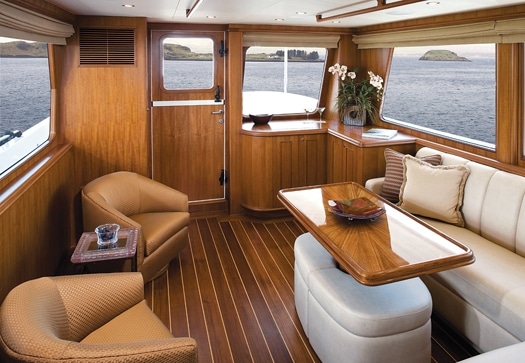
| | |
Inside, the 60 Trawler salon is very pleasant, but clearly designed for the realities of cruising, from the watertight Diamond Sea-Glaze Dutch door with dogging latches to the teak-and-holly sole (because you’ll probably be tramping through with squishy shoes). There’s an L-settee to port as well as a corner cabinet with pop-up TV, and a pair of loose bucket chairs that can be used with the absolutely gorgeous teak folding table. Big windows surround the area for sit-down visibility, and the overhead sports a pair of sturdy handrails.
The galley is up two steps, forward, and open to the salon above the sink. A full-sized Sub-Zero fridge with two freezer drawers is camouflaged behind burled panels and our test boat was upgraded from the Force 10 propane cooktop to a four-burner Gaggenau cooktop with oven. Under the counter is a Fisher & Paykel dishwasher and, at eye level, a microwave. Counter space, with Silestone tops, is at a premium, although there is a food-prep area just outside the galley to starboard.
Three steps above the galley is the pilothouse, with the usual settee and table overlooking the helm and instrument panel, which is once again a black fascia large enough for a full array of goodies. A Stidd pedestal chair is behind a teak steering wheel that qualifies as a work of art.
I found an interesting contradiction at the helm because, after the dogging doors and offshore sensibilities elsewhere, all the horizontal space around the helm is padded and upholstered. Though there’s plenty of space to lay out a chart, I’d be wary of sticking dividers into this supple material or trying to draw a penciled course on a pillowy surface. Ocean Alexander provided two chart drawers to port, so I guess the skipper is expected to use the settee table for any chart work. Or maybe OA trusts electronic chart plotters more than I.
A nice touch, on the other hand, is that, because the pilothouse helm is far enough forward, it allows a big screened hatch directly over the skipper’s chair, which would be great in balmy climes. And there are two handrails overhead for moving around in a seaway.
Stairs to port lead below, past a nicely labeled electrical panel protected by a Lucite cover for easy access. The VIP cabin is forward from the small foyer, with a queen-sized berth between twin burled pillars and raised to provide drawers below. The cabin has a private head with a surprisingly large shower stall.

| | |
Down three steps aft of the foyer is the master stateroom, which spans the full beam and has a queen-sized berth, again centered under a padded headboard with burled pillars. A bureau is to port, while the head is along the starboard side with a space-saving pocket door and a man-sized shower with a seat.
Just aft and down a couple of steps is a compartment that can be finished in several ways-for instance, as a crew compartment with a pair of bunks, accessed by stairs from the salon. In the case of our test boat, it was turned into a dressing-area-cum-laundry, with large cedar-lined hanging lockers, drawers, stacked Maytag washer and dryer, and even a U-Line fridge and mini-sink.
Once inside the engineroom, you’ll find more than ample room to walk around the twin 455-horsepower Cat C7s, a worthwhile upgrade from the standard single 300-horsepower John Deere. There’s a wide alley between the mains and you can get around behind them, although the single 12 kW Northern Lights generator outside the starboard engine is a bit tight. The compressors for the 76,000 Btu Cruisair a/c are outboard of the port engine, and a Delta-T blower system keeps the area well ventilated. Our test boat had been thoughtfully outfitted, including Keypower bow and stern thrusters, a 3,000-watt Prosine inverter and a Glendinning Cablemaster.
Underway, the 60 was pleasantly predictable and without surprises. The steering was light but positive, sight lines from the bridge and lower helm were above average, and, though we didn’t have any breaking seas to challenge us, she had a solid feel that I’m comfortable would translate into a nice sea boat. In close-quarters maneuvering, I made good use of the bow and stern thrusters because she has a fair amount of windage and we had crosswinds and an awkward slip.
Ocean Alexander engineers suggest that our top speed should have been around 14 knots at wideopen throttle, but we fell below that for reasons that should be mentioned. Every sailboat racer knows how much speed a freshly scrubbed bottom can add, and the 60 had some visible marine growth. We also ran in Florida’s St. Lucie River, which at times was only a few feet deeper than our draft, and this probably dragged our speed down by a knot as well.
In the end, however, the Ocean Alexander 60 Trawler Extended Cruiser proved to be a thoroughly likable addition to the world of cruising yachts. She’ll be an easy boat to shorthand with a husband-and-wife crew and, depending on her configuration, could provide space for kids or a captain. Pick the layout that fits your needs, check off some options, and cast off: This is one for voyaging.
Ocean Alexander, (800) 815-4081; **www.oceanalexander.com**


